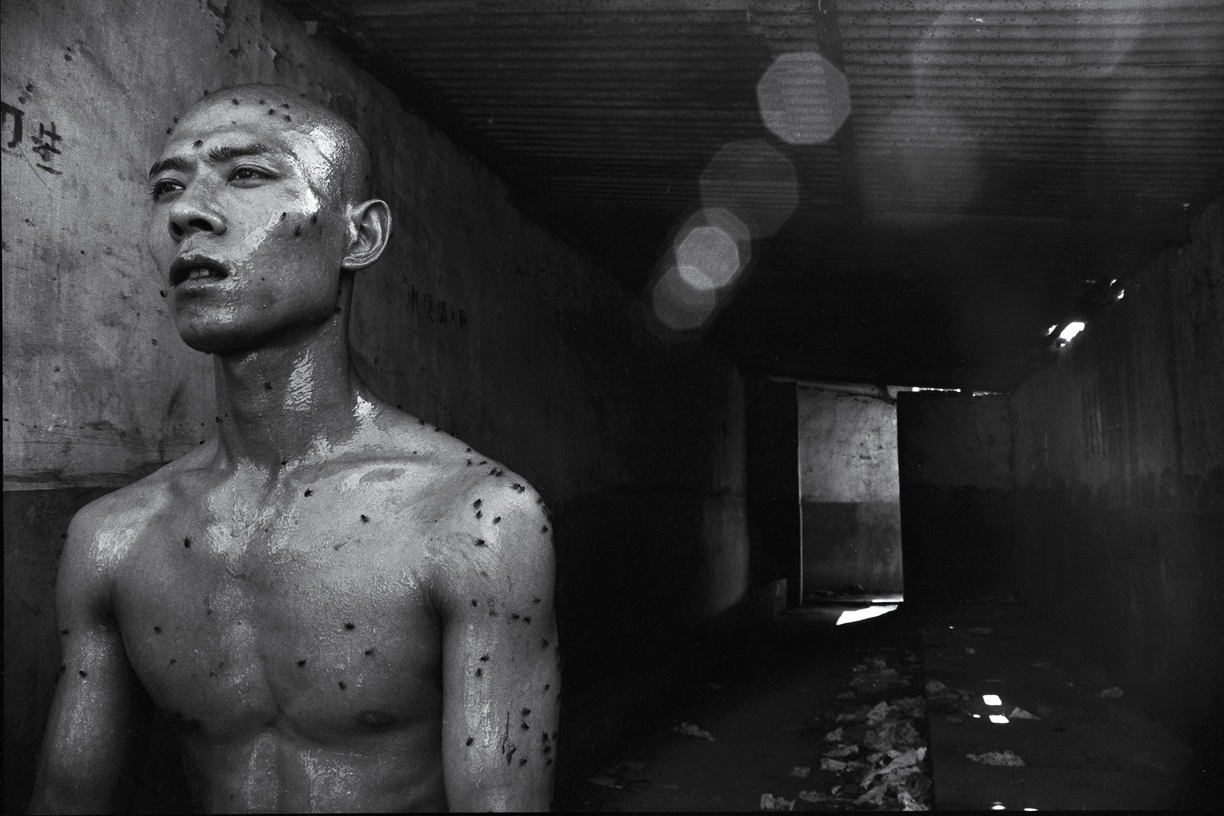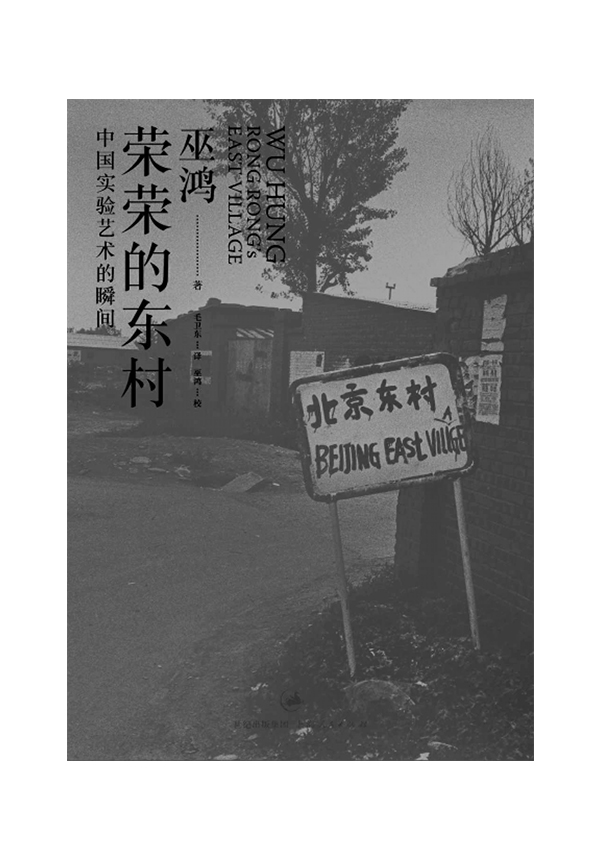RongRong
Series of Wedding Dress, 1997~2000
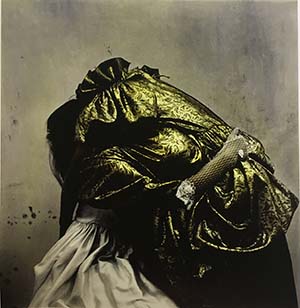 1995 No.05(2) Hand-‐dyed gelatin silver prints 50.8×61cm/100×100cm | 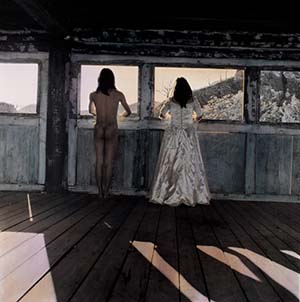 1997 No.02(2) Hand-‐dyed gelatin silver prints 50.8×61cm/100×100cm |  2000 No.01(4) Hand-‐dyed gelatin silver prints 50.8×61cm/100×100cm |
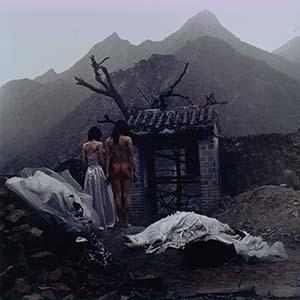 1999 No.08(1) Hand-‐dyed gelatin silver prints 50.8×61cm/100×100cm | 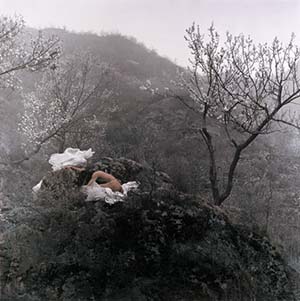 1999 No.03(1) Hand-‐dyed gelatin silver prints 50.8×61cm/100×100cm | 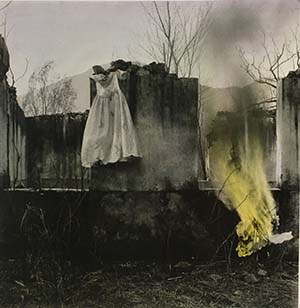 1997 No.03(1) Hand-‐dyed gelatin silver prints 50.8×61cm/100×100cm |
Series of Fragment, Beijing 1998
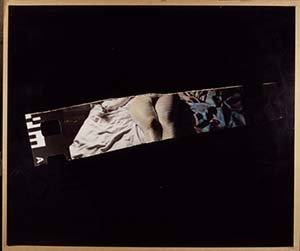 No.25 Gelatin silver print 50.8×61cm/100×150cm | 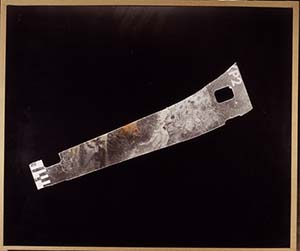 No.24 Gelatin silver print 50.8×61cm/100×150cm | 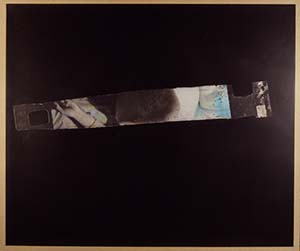 No.23 Gelatin silver print 50.8×61cm/100×150cm |
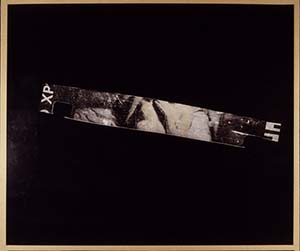 No.20 Gelatin silver print 50.8×61cm/100×150cm | 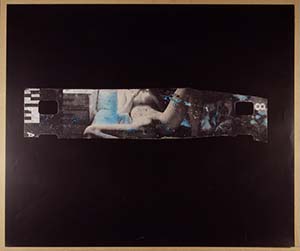 No.22 Gelatin silver print 50.8×61cm/100×150cm | 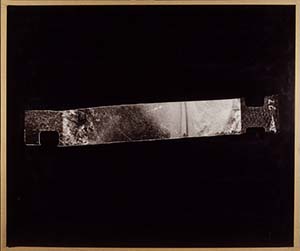 No.09 Gelatin silver print 50.8×61cm/100×150cm |
Series of Ruin pictures 1996-1998
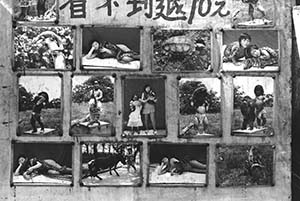 1996 No. 9 (1) (2) (set of 2 pieces) Gelatin silver print 61×50.8cm/150×100cm |  1998 No.27 Gelatin silver print 61×50.8cm/150×100cm | 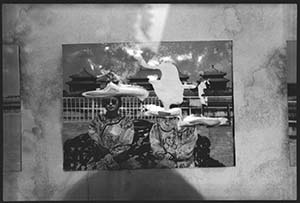 (007)2-22 Gelatin silver print 61×50.8cm/150×100cm |
 1998 No.16(2) Gelatin silver print 50.8×61cm/100×150cm | 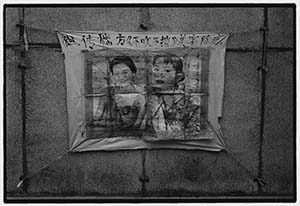 1998 No.11 Gelatin silver print 50.8×61cm/100×150cm | 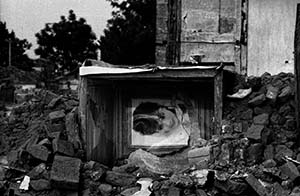 1997 No.1(2) Gelatin silver print 50.8×61cm/100×150cm |
Series of East Village, 1993~1998
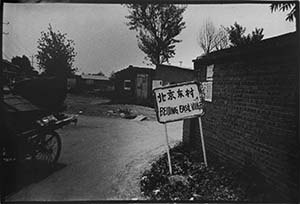 1993 No.17 Gelatin silver print 61×50.8cm/150×100cm | 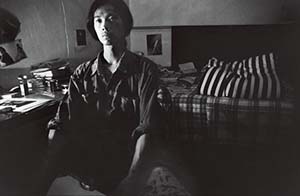 1998 No.27 Gelatin silver print 61×50.8cm/150×100cm | 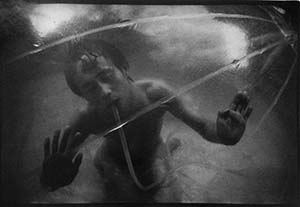 1993 No.25 Gelatin silver print 61×50.8cm/150×100cm |
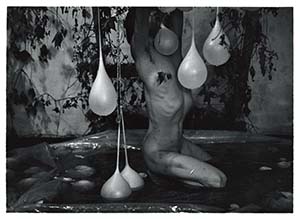 2003 No.1 Gelatin silver print 50.8×61cm/100×150cm | 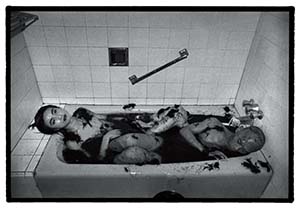 1994 No.11 Gelatin silver print 50.8×61cm/100×150cm | 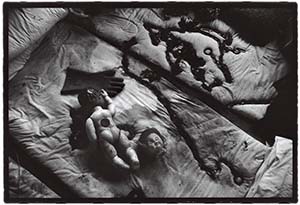 1994 No.20 Gelatin silver print 50.8×61cm/100×150cm |
From Six Mile Village to Three Shadows Studio
Wu Hung
A few years ago when I began writing Rong Rong’s East Village,[i] I wanted to discuss three things. While each of the three had its own distinct scope and theme, all were inseparable from understanding contemporary experimental art in China and the artists who practiced it. The first task was to interpret specific works of art, particularly to unearth the most interesting ones and explore their depths, as this is the basis of understanding any art or artist. The second task was to document and restore the artists’ living and working environment at that time, mainly by consolidating fragmentary information of their lived experience, emotion, and desire into a coherent picture. The third was to place these works and artists into the larger framework of contemporary Chinese urban, social, and cultural space. What was Rong Rong’s East Village? Why did he gather with other artists from far-flung reaches of the country in this small village on the periphery of Beijing, filled with garbage and industrial waste? What connection did they have to this place? What would be the fate of the East Village? Why did it disappear without a trace, leaving not even a broken brick or shattered tile to mark its presence? When I looked at the pictures of Rong Rong’s East Village and asked these questions, I hoped to understand—and indeed did gradually come to understand—not only the artistic nature of each photograph and the life experience of the photographer who made them, but also the fate of a city, the intimacy and struggle with which people inhabit their environments, and the uncontrollable tragedy of history.
Photographs of Liulitun (literally, Six Mile Village) by Rong Rong and inri might be considered a continuation of Rong Rong’s East Village. The earliest works here were created shortly after the East Village artist community was disbanded, and Rong Rong moved to the nearby village of Liulitun in 1995. Writing this brief essay, I am still thinking of the three perspectives mentioned above: artworks, the artist, the city. As time passes by, Liulitun leads us step-by-step through the last years of the twentieth century, and on into the twenty-first. We see how Rong Rong’s lens and life gradually evolve, and how Beijing’s merciless expansion—that massive wheel of destruction and reconstruction—keeps on turning. At the dawn of the century, a Japanese girlwho speaks with her eyes enters into this strange, small courtyard; she is inri. From this point on, she and Rong Rong and Liulitun find meaning in a soundless dialogue. Two years later, the wheel of destruction encroaches, finally crushing Liulitun. When their courtyard was turned into a pile of bricks, Rong Rong and Inri held a privatefuneral atop the ruins, holding fresh white flowers in their hands.
I first met Rong Rong in Liulitun. It was the summer of 1997, when I was preparing the exhibition Transience: Experimental Chinese Art at the End of the 20th Century.[ii] One major goal of this exhibition was to shift the focus of the introductory research then being done on Chinese contemporary art from collectivity to individuality. As I saw it, this transition was of utmost importance for the exhibitions of this art then being mounted abroad, because for most foreign critics and viewers at that time, Chinese contemporary art, regardless of whether it was called “avant-garde,” “experimental,” “unofficial,” or “underground,” was unfailingly seen as a collective political behavior, meaningless outside the context of the post-Cultural Revolution political environment inside China or the post-Cold War international situation. Transience sought rather to portray Chinese contemporary art as a collection of individual artistic voices. This individuality, of course, was not isolated or absolute, because these artists did indeed face similar political, social, and artistic questions. But they were “experimental artists” precisely because each one reacted differently to a set of common questions and problems, resulting in creation and innovation in terms of form, style, and visual language. This idea of individuality became the center of the exhibition and the theme of its catalogue. For the catalogue, I wrote twenty-two short essays exploring the work of individual artists; the material for these articles came from my interviews with the artists as well as their notes, writings, plans, and drawings. I did some of these interviews at the Overseas Chinese Hotel (the place where I most liked to stay when I came back to China in those years), but I alsofelt it important to see the artists in the spaces where they lived and worked. And that is why I went to visit Rong Rong in Liulitun.
Even after many years, I remember that visit like it was yesterday. Rong Rong described to me the rough location of Liulitun over the phone, outside the Third Ring Road, close to the Fourth Ring then under construction. He would wait for me by the roadside. With this in mind I hired a cab and had it drive straight east along Agricultural Exhibition Center South Road. The road was newly constructed: flat, broad, empty. The cab passed the Second Ring, then the Third, as the tall buildings grew scarcer. Workers were erecting traffic lights and electric poles along the street; sluggish pedestrians waddled across. The cab suddenly stopped in the middle of the road, when the driver turned around and said, “No way to go on, no more road.” I got out and looked around, and indeed things were as he said. The road ended under my feet, the pavement stopped, in front of me only bright green cropland. For just an instant I forgot where I was: I have never had another experience like this—no matter what the road, it always leads somewhere. There are no roads to nowhere. I felt absentminded, as if in a dream I had wandered to the edge of the world, where going one step forward would mean falling off a cliff. Snapping out of it, I asked the driver to turn the car around and drive slowly back. Less than a hundred meters back, Rong Rong was standing by the side of the road, his long hair blowing in the wind. I mumbled to myself, “Liulitun, the end of Beijing, the end of the world.”
This feeling of being at the end of the world grew deeper as the afternoon went on. Rong Rong led me off the empty road, down a bumpy dirt road into a little village, and finally to his small courtyard. In those five minutes I was taken back to days twenty or thirty years before, back into the recesses of my familiar, endless, eternally recurring past. No one knows how old this past is: humble brick and tile homes, faded latticework, deep shadows under overhanging eaves, the rising and falling chirp of cicadas at high noon. It is as if these have always been and always will be. But in 1997, this feeling of safety and permanence was but an illusion. As soon as I saw Rong Rong’s work, I immediately realized that for him, the quiet laziness and exhaustion of Liulitun were full of crisis. Yet like the eye of a storm, the tranquility at the heart of this crisis had made the artist’s nerves all the more sensitive, observing every drop of the present amidst this anxious state of waiting, listening in silence to the clamor moving in from afar. Thus this feeling of timelessness, this state of meaninglessness—the humble homes and faded latticework, the eaves and their shadows, the chirping noontime cicadas—was endowed with a biting sense of time, a special significance.
That day Rong Rong showed me his series Untitled, which I have since referred to as “ruin pictures.” This name has several meanings for me. On one level, “ruin pictures” expresses the ascendance and scale of demolition in Beijing. In these pictures, tiled buildings and courtyard dwellings have been transformed into desolate, dilapidated piles. The former occupants have moved on, and the images retain the tranquility of a cemetery. But on another level, these photographs also represent “ruined image”: the central image in each picture is a leftover poster amidst the rubble, often faded portraits of glamorous movie stars. Another related group of works frees the theme of ruin images from the realities of architecture altogether: these are images displayed in public settings, faded and damaged by the bright sun. I have already written of these works in articles and books, but here I would like to add one more point: these works marked the beginning of Rong Rong’s “Liulitun Moment.” They are photos about the fate of buildings like the then still-undemolished one in which he lived, and about the fundamental fragility of the image itself. Unlike the collective nature of the “East Village Moment,” this “Liulitun Moment” belonged to an independent artist. For Rong Rong, this independence is reflected in meditations about death, tragedy, and limitation.
I would visit Liulitun many more times, going to see Rong Rong’s new work and that of the other artists living in that courtyard. Although at times one could still feel the echoes of the earlier East Village—gatherings of friends eating and drinking together, debating the world, the occasional performance by one artist or another—still the atmosphere of that courtyard grew ever quieter and more closed. Little by little it became the living and working space of a single artist, filled with the secrets and ambiguities of a private life. The ivy on the gate grew thicker, the sounds of cars and people outside seemed to grow more and more remote. “Ruins” remained a theme in Rong Rong’s photography, but each new work grew in refinement and size, as their content likewise grew more romantic and theatrical. He had always liked to photograph himself, and was now filling the twin roles of director and actor. Some of these new photographs were hand colored, bearing traces of their author’s participation in the post-production process. These changes resulted in the series Wedding Veil and Ghost Village.
These are two exceptionally beautiful series, which portray decay and melancholy through images of a young man and woman wandering atop ruins, like songs without words. I can pick Rong Rong out of every image, whether he is naked or dressed in the bright cloak of a woman. But I had never met the girl who appeared with him, and so she has remained for me an abstract symbol, a ghost-like image existing only in the photographs. This image became real only at the moment when inri appeared. Then I understood. The melancholy that came before, the hesitation amidst the ruins—all were but expressions of Rong Rong’s expectation.
Perhaps that was in 2000, when we—my wife Judith, my daughter Lida, and I—became Rong Rong and inri’s friends. It was all so natural. She appeared in that courtyard in Liulitun, bearing the lightest tea on a small tray, smiling. “Tea,” she said (in her newly acquired Chinese). Then, turning to face the lazy cat roaming the courtyard, she smiled and said, “Cat.” But the pictures she made while in Tokyo allowed me to know the pre-Liulitun inri. That was a time of colorless pupils and convulsing bodies staring out of black-and-white photographs, a brilliant feminine face struggling toward collapse, shadowy urban spectacles of Tokyo emerging under streetlamps. There was no substance or weight, just the anticipation and anxiety before the climax and the weightlessness and collapse that followed.
These works are utterly different from the photographs she produced while living in Liulitun. The latter consist of innumerable fragments of daily life and piecemeal emotion, presented openly for the first time as galley proofs in an exhibition in New York’s Chamber Fine Arts in 2006.[iii] The vertical and horizontal rows of images have not been cut or edited. There is no spatial coherence or sequential narrative; the only constant is the eye behind the camera, that of inri, curiously observing the extent of her surroundings, and focusing mostly on Rong Rong, his eyes, his camera. I can understand why inri has not made these proofs into individual artworks, placing them into exquisite frames: these fragments are just her life, a life she had never before experienced and will never again experience.
These photographs also make me understand more deeply the last series of works in that exhibition: when their courtyard was razed to the ground along with all of Liulitun in 2002, Rong Rong and inri held a funeral for this place and a farewell to the “Liulitun Moment” in their own lives. This moment began when Rong Rong discovered “ruins” and ended with his encounter and union with inri. Once Liulitun had disappeared, they left this place that would never again exist, moving into a world without end. A batch of works reflecting youth and full of desire for beauty had been produced, marking a new transcendence. In my imagination, this transcendence is like that of the spring cicadas climbing arduously out of the ground, bit by bit up the trunks of tall trees, shedding their shells, and finally flying off into the blue sky. For this reason, when I curated their two-person show in the Great Furnace Room of Beijing’s Factory 798 in September 2003, I chose the name Tui-transfiguration as a poetic expression of this process of transcendence, and as a remembrance and recollection of their bygone days in the East Village, Tokyo, and Liulitun.
§
I titled the last part of the Tui-transfiguration “Rebirth,” and commented on it in the exhibition catalogue: “A fascination with beauty and youth is the dominant theme of the third section of the exhibition, which feature two groups of collaborative works that Rong Rong and inri created after they had found each other and fallen in love. As if reborn from ruins, nature, still unspoiled, comes back to life. The two photographers embrace this amazing world. Harmony has triumphed, struggle has subsided. Sensual pleasure has returned to become the main purpose for artistic creation; even the frozen, frightening winter landscape of Mt. Fuji inspires joy.”[iv]
First seen in the tranquil photographic images that these two artists created together in 2001 and 2002, this rebirth finally materialized in their founding of Sanyingtang---the Three Shadows Studio (the formal name is the Three Shadows Photography Art Center) at Caochangdi on the east edge of Beijing. Solely funded by themselves, this 4,600 sq meters complex is an ambitious undertaking with facilities including two large exhibition halls,a conference room, a library, darkrooms, a café, and spaces for outdoor activities. Ai Weiwei’s design further bestows the central building and surrounding yards with additional architectural significance. When the writer Sheila Melvin interviewed me in 2007 upon the Center’s opening, I told her that these two artists "have done something quite important. There are so many museums and galleries sponsored by companies or governments, but I think this is the first sponsored by artists---and for idealistic reasons."[v] About the first exhibition the Center organized, called New Photo---Ten Years and co-curated by Zhang Li and me, I told Melvin again: "I suggested this show because I felt they first should establish a historical perspective. I also feel that China moves so fast that the artists don't always think---they have instinct and ambition, but they need to think about what is Chinese contemporary photography."[vi] Now in its second year, Sanyingtang has developed into a mature institution with a varied exhibition and education program, and has begun to attract wide attention internationally. This is not the only result of Rong Rong’s and inri’s rebirth, however: with the founding of the Sanyingtang they have also created a large body of photographs recording its emergence from Beijing’s frozen earth, as well as the expansion of their family: since the Liulitun Moment they have given birth to two children and are awaiting the third.
[i] Wu Hung, East Village (New York: Chambers Fine Art, 2003).
[ii] This exhibition opened in Smart Museum of Art, University of Chicago, in February 1999.
[iii] Entitled Liulitun: RongRong and inri, this exhibition was held in Chambers Fine Arts from October to December 2006 and was accomplished by a lavish catalogue of the same title,
[iv] Wu Hung, RongRong & inri: Tui-Transfiguration (Beijing and Hong Kong: Timezone8, 2004), p. 188.
[v] Sheila Melvin, “Photography as art comes into its own in China,” International Herald Tribune, August 6, 2007.
[vi] Ibid.
| 荣荣的东村:中国实验艺术的瞬间
巫鸿 著 |

RongRong
Rongrong was born in Fujian, China in 1968, contemporary photographer also the founder and director of Three Shadows Photography Center. Rongrong produced many well-known photographs including “East Village”,“Liulitun”,“Caochangdi”and “In Fujisan” based on the critical thinking of the beauty of the human body in nature and the urban environment. Rongrong’s photos have been acquired the collection of MOMA, Getty Museum, Myriam Guy Ullens foundation, Tokyo Metropolitan Museum of Photography and Mori Art Museum and some distinguished private foundations.
In June 2007, RongRong together with his wife, Japanese photographer, inri established the very first non-profit Three Shadows Photography Art Centre in China with the commitment of demonstration, communication and promotion of Chinese contemporary photography, also to create the premier platform for international research and interaction through series of education, publication and international artist residency projects. During 6 years, Rongrong plays active role in programming and curating cross-discipline exhibitions, seminars and salon across eastern and western countries, such as the initiation of “PhotoSpring—Arles in Beijing”in the continuation of three years, “Nobuyoshi Araki: Sentimental Journey/Decadence in Paradise” as well as the celebrated“Three Shadows Photography Awards” that just achieved its six-year milestone. Three Shadows is obliged to progressively realize his goals and visions upon presenting potential photographers and having Chinese contemporary photography gradually enter the global public sphere.
EDUCATION:
RongRong | 1992 | Central Industrial Art Institute, Beijing |
SELECTED SOLO EXHIBITIONS:
| 2019 | Day After Day: RongRong and the Beijing East Village. The Walther Collection Project Space, New York, USA |
2017 | Huang Rui and RongRong - Photo Symbiosis, Three Shadows Photography Art Centre, Beijing |
2016 | RongRong&inri: Tsumari Story, 10 Chancery Lane Gallery, Hong Kong RongRong&inri: Tsumari Story, Chambers Fine Art, New York Memories Through Cycle, Art Tower Mito, Mito Sony World Photography Awards, Somerset House, London |
2015 | Geography: Documents and Works by RongRong&inri, Three Shadows +3 Gallery, Beijing Tsumari Story, Kyoto Graphie international photography festival, Kyoto Focus: RongRong&inri, the Modern Art Museum of Fort Worth, Fort Worth, Texas |
2014 | Tsumari Story, Three Shadows Photography Art Center, Beijing Tsumari Story, Mizuma Art Gallery, Tokyo |
2012 | Rebirth from Ruins: RongRong&inri Photography 2002-2009. Kuhlhause, Berlin Tsumari Story2012, Echigo-Tsumari Art Triennale, Echigo, Japan |
2011 | Three Begets Ten Thousands Things, Blindspot Gallery, Hong Kong Three Begets Ten Thousands Things, Shiseido Gallery, Tokyo Ruins Series: 1996-1998, Chambers Fine Art, Beijing RongRong&inri, Michael Ku Gallery, Taipei |
2010 | RongRong&inri: Selections from the Three Shadows Collection, Three Shadows Photography Art Centre, Beijing RongRong&inri, MEM Gallery, Tokyo Compound Eye, HeXiangNing Art Museum, Shenzhen |
2008 | From Six Mile Village to Three Shadows New Works by RongRong&inri, Three Shadows Photography Art Centre, Beijing Ruins to Renewal: Works by RongRong & inri, SF Cameraworks, San Francisco RongRong & inri: The Power of Ruins. Between Destruction and Construction, Casa Asia, Madrid and Barcelona |
2007 | RongRong & inri, Rencontres d' Arles, Arles |
2006 | The Third Space, Alexander Ochs Gallerie, Berlin Liulitun, Chambers Fine Art, New York |
2005 | Beyond, Walsh Gallery, Chicago |
2003 | Tui-Transfiguration: The Image World of RongRong&inri, Dashanzi Art district, Beijing Rong Rong's East Village, Chambers Fine Art, NewYork |
2002 | Ruin Pictures RongRong, Chambers Fine Art RongRong – Retrospective, Galerie Loft, Paris |
2001 | RongRong, Fundacao Oriente, Macau RongRong,Contemporary photography from China, Chambers Fine Art, NewYork |
1998 | RongRong Solo photo show, Galerie H.S. Steinek, Vienna |
1997 | RongRong Solo photo show, French embassy cultural section, Beijing |
SELECTED GROUP EXHIBITIONS:
| 2018 | Life and Dream: Contemporary Chinese Photography and Media Art, The Walther Collection, Neu-Ulm, Germany |
2018 | Practice and Exchange: An Exhibition of Chinese Contemporary Art, UCCA, Beijing |
2017 | Art and China after 1989: Theater of the World, Guggenheim, New York 40 Years of Chinese Contemporary Photography, Three Shadows Photography Art Centre, Beijing |
2016 | Why are we doing what we are doing?, Mizuma Gallery, Singapore Sony World Photography Awards Exhibition, Somerset House, London An Art Exhibition to celebrate the Anniversary of the Tasmania-Fujian Sister State Relationship, Fujian Museum, Fuzhou 4th Annual Collectors’ Contemporary Collaboration, Hong Kong Art Centre, Hong Kong |
2015 | Designing view beyond the earth: The first Xi’an contemporary art document exhibition, Xi’an Art Museum, Xi’an We may have met before—Chinese Contemporary Photography, Foam Amsterdam, Amsterdam Chinese Photography: Twentieth Century and Beyond, Three Shadows Photography Art Centre, Beijing The Second Beijing Photo Biennial, Beijing The photography: What You See & What You Don’t, Tokyo |
2014 | Hans van Dijk: 5000 Names, Ullens Center for Contemporary Art, Beijing HongKong International Photography Festival, HongKong China Photography 1911-2014, Stavanger Art Museum, Stavenger The Symposium of Challenge the Tradition-20th Century Western Classical and Chinese Contemporary Photography, Inside-Out Art Museum, Beijing China ARTE Brasil Exhibition, São Paulo Hanart 100: Idiosyncrasies, Hanart TZ Gallery, Hong Kong |
2013 | Portrait of the Times—30 Years of Chinese Contemporary Art, Power Station of Art, Shanghai How Far—Exhibition of Chinese Contemporary Photography, Songzhuang Art Center, Beijing New Framework: Chinese Avant-garde Photography 1980s-90s, Blindspot Gallery, Hong Kong Collection Exhibition 2013: The Aesthetics of Photography, Tokyo Metropolitan Museum of Photography, Tokyo All you need is Love: 10th Anniversary Exhibition, Mori Art Museum, Tokyo |
2012 | Transformation: A View on Chinese Contemporary Art, Istanbul Modern, Istanbul Passing Through Memory, Suzhou Jinji Lake Art Museum Opening Exhibition, Suzhou Jinji Lake Museum, Suzhou To Walk Alone: Contemporary Chinese Photography, Toyko Photo, Tokyo WORLD BOUNDARY: Three Realms & Ten Directions Exhibition, Echigo-Tsumari Go Figure! Contemporary Chinese Portraiture, National Portrait Gallery, Canberra |
2011 | Staging Action: Performance in Photography since 1960, Museum of Modern Art, New York New Photography from China, Getty Museum of Art, Los Angeles Interconnected: Selections from the Three Shadows Collection, Three Shadows Photography Art Centre, Beijing |
2009 | Europalia—International Art Festival, Brussels Art Museum, Brussels Third Guangdong International Biennale, Guangdong Museum of Art, Guangzhou |
2008 | DIOR & CHINESE ARTISTS, Ullens Center for Contemporary Art, Beijing LASST HUNDERT BLUMEN BLÜHEN Der Dresdner Kunstverein 2008 Daegu Photo Biennale, Daegu Right Hand, Left Hand—Couples in Contemporary Art, MOCA Shanghai, Shanghai |
2007 | Net: Reimiganing Space, Time and Culture, Chambers Fine Arts Gallery, Beijing Convection, Three Shadows Photography Art Centre, Beijing NEW PHOTO Ten Years,Inaugural Exhibition of Three Shadows Photography Art Centre, Three Shadows Photography Art Centre, Beijing |
2006 | Another world - photography from China, Lukas Feichtner Gallery, Vienna Intimate Beijing–Photography exhibition (China–Japan–Netherlands), 706 Factory, Beijing Inner Scopes, Shanghai Gallery of Art, Shanghai China Now, Sammlung Essl/Essl Collection, Vienna |
2005 | About Beauty, House of World Cultures, Berlin Mahjong: Contemporary Chinese Art from the Sigg Collection, Kunstmuseum Bern, Bern |
2004 | 5th Shanghai Biennale-Techniques of the Visible, Shanghai Art Museum, Shanghai All Under Heaven, Museum van Hedendaagse Kunst, Antwerpen Le moine et le demon: Art Contemporain Chinois, Musée Art Contemporain Lyon, Lyon Between Past and Future: New Photography and Video from China, International Center of Photography, Asia Society, New York; Smart Museum of Art, Chicago; Museum of Contemporary Art, Chicago |
2003 | Chinart, Museum Kuppersmuhle Sammlung Grothe, Duisburg; Museo Arte Contemporanea di Roma, Roma; Ludwig Museum, Budapest A Strange Heaven, Galerie Rudolfinum, Prague |
2002 | Beijing Afloat, Beijing Tokyo Art Projects, Beijing Dream 02, Red Mansion Foundation, London Paris – Pekin, Espace Cardin, Paris Guang Zhou Triennial, Guang dong Museum of Art, Guang Zhou |
2001 | Chinese Contemporary Photography, Galerie Steinek-Halle, Vienna Cross Pressures, Oulu City Art Museum, Oulu; The Finnish Museum of Photography, HelsinkiRongRong. Piafries, The Box Associati, Torino Promenade in Asia Beijing-Seoul-Taipei-Tokyo, Shiseido Gallery, Tokyo China-Naarden Wall-to-Wall, Fotofestival Naarden 2001, Amsterdam China Contemporary Art Rouges, Galerie Loft, Paris China Art Now!, Singapore Art Museum Chinese Contemporary Photography, Halle Steinek, Austria (RongRong & inri) KUNST, Artist in Residence Program |
2000 | Fuck Off, East Link Gallery, Shanghai From Inside the Body, ISE Foundation Gallery, New York Chinese Contemporary Photography, Ethan Cohen Fine Arts,New York Home: Motions by Contemporary Artists, Shanghai I giovani: ilmondo la fotografia, 1a Mostra Fotografica Internazionale, Alessandria BIG TORINO 2000, biennale of emerging artists, Torino |
1999 | Fire: Memory of 100 Years, Haung Rui Studio, Osaka Love: Chinese Contemporary Photography & vide, Tachikawa Art Festival, Tokyo La Biennale d' Issy, Paris Beijing in London, ICA, London. 99 China-Japan Contemporary Art Exhibition, Fuzhou, China; Aichi, Japan and Kagoshima, Japan Unveiled Reality Contemporary Photography, Museum of Chulalongkorn University, Thailand/ Art Beauts Gallery, Canada. TRANSIENCE: Chinese Experimental Art at the end of the Twentieth Century, Smart Museum of Art, Chicago University |
1998 | FIAC, Stand of Galerie Jeanne Bucher, Paris Art Basel, Stand of Galerie Alice Panli, Basel |
1997 | Contemporary Chinese Photography, Neuer Berliner Kunstverein, Berlin |
1996 | Chinese Avant -Garde Art show, Gallery Q, Tokyo |
1995 | China's New Photos three person show, Tokyo Gallery, Tokyo |
PUBLICATIONS:
2014 | RongRong&inri: Tsumari Story. Texts by John Tancock, Tokihiro SATO, Fram KiTAGAWA and RongRong&inri. Three Shadows Press Limited and Saneido Co.,Ltd., Beijing and Kanagawa. |
2011 | RongRong&inri: Three Begets Ten Thousand Things. Text by Mimi Gradel. Blindspot Gallery, HongKong. RongRong&inri: Three Begets Ten Thousand Things. Text by Lizawa Kotaro. Shiseido Gallery, Tokyo. |
2010 | RongRong&inri: Compound Eye. Texts by Feng Boyi and Wu Hung. HeXiangning Art Museum, Shen Zhen. |
2008 | From Six Mile Village to Three Shadows-New Works by RongRong&inri. Text by Wu Hung. Three Shadows Photography Art Cerntre, Beijing. RongRong&inri: El poder de las ruinas. Texts by Jesus Sanz, Menene Gras Balaguer, Wu Hung, Ai Weiwei, Zhang Li, Christopher W. Mao and RongRong&inri. Casa Asia, Barcelona. |
2006 | RongRong&inri: Liu Li Tun. Texts by Christopher W. Mao, Zhang Li, Ai Weiwei and Wu Hung. Three Shadows Photography Art Cerntre and Chambers Fine Art, Beijing and New York. |
2005 | Beyond: Recent photographs by RongRong&inri. Texts by Julie Walsh and Wu Hung. Walsh Gallery, Chicago. |
2004 | RongRong&inri: Tui-Transfiguration. Edited by Wu Hung and RongRong&inri. Timezone 8, Beijing&HongKong. |
PUBLIC COLLECTIONS:
Smart Gallery of University of Chicago, Chicago
Singapore Art Museum, Singapore
Essl MUSEUM, Vienna
The Museum of Modern Art, New York
Ivory Press, Madrid
Guy & Myriam Ullens Foundation, Switzerland
LVMH Foundation, Paris
The Red Mansion Foundation, London
The Estella Collection, Denmark
Sigg Collection, Swizerland
Tempere Art Museum, Finland
Tokyo Metropolitan Museum of Photography, Tokyo
Shiseido, Japan
He Xiangning Art Museum, Shenzhen
Three Shadows Photography Art Center, Beijing
AW Asia, New York
Getty Museum, Los Angeles
DSL Collection, France
The Metropolitan Museum of Art, New York
CAFA Art Museum, China

